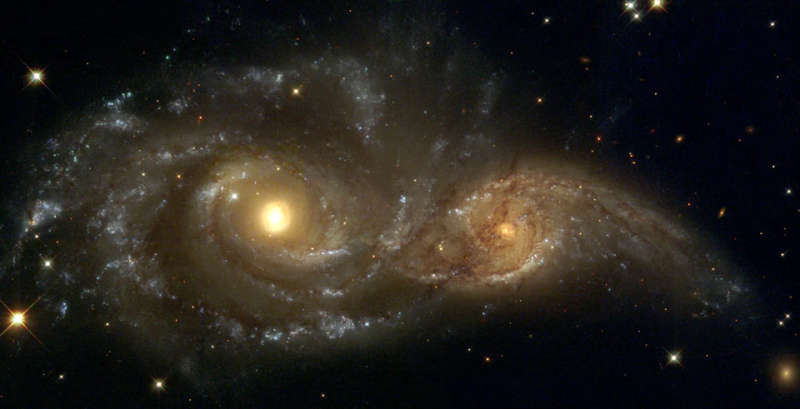
|
Credit & Copyright: Debra Meloy Elmegreen
(Vassar College)
et al.,
& the Hubble Heritage Team (AURA/STScI/NASA)
Explanation:
Billions of years from now, only one of these two galaxies will remain.
Until then, spiral galaxies NGC 2207 and IC 2163 will slowly pull each other apart,
creating tides of matter, sheets of
shocked gas, lanes of
dark dust, bursts of
star formation, and streams of
cast-away stars.
Astronomers predict that NGC 2207, the larger galaxy on the left, will
eventually incorporate IC 2163, the smaller galaxy on the right.
In the most
recent encounter that about peaked 40 million years ago,
the smaller galaxy is swinging around counter-clockwise,
and is now slightly behind the larger galaxy.
The space between stars is so vast that when
galaxies collide,
the stars in them usually do not collide.
& the Hubble Heritage Team (AURA/STScI/NASA)
|
January February March April May June July August September October November December |
| ||||||||||||||||||||||||||||||||||||||||||||||||
NASA Web Site Statements, Warnings, and Disclaimers
NASA Official: Jay Norris. Specific rights apply.
A service of: LHEA at NASA / GSFC
& Michigan Tech. U.
Based on Astronomy Picture
Of the Day
Publications with keywords: interacting galaxies
Publications with words: interacting galaxies
See also:
- Galaxies in the River
- APOD: 2025 August 19 Á Giant Galaxies in Pavo
- APOD: 2025 June 1 Á UGC 1810: Wildly Interacting Galaxy from Hubble
- APOD: 2025 March 12 Á NGC 772: The Fiddlehead Galaxy
- Peculiar Galaxies of Arp 273
- APOD: 2025 January 6 Á Colliding Spiral Galaxies from Webb and Hubble
- Shell Galaxies in Pisces
